How to feed strawberries in spring for a big harvest: the best fertilizers
A good strawberry harvest depends on many factors: on the climatic and weather conditions of the current season, on the variety, as well as on complex care. Despite the importance of the listed elements, the yield depends to the greatest extent on whether the strawberries were fertilized correctly in the spring. Only by growing in soil rich in basic macro-and microelements, plants will be able to form large and tasty berries and give the summer resident the desired harvest.
Next, you will learn how and what is the best way to fertilize strawberries in spring in order to increase their yield and berry quality.
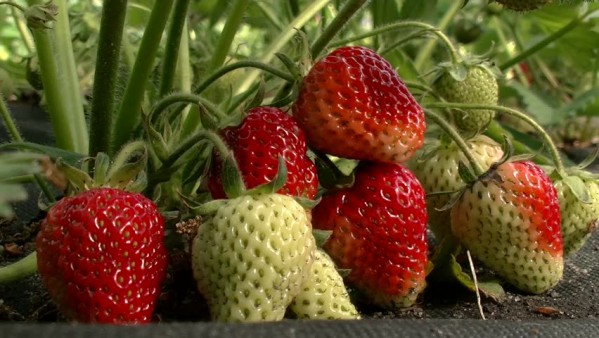
Content
- 1 Why fertilize strawberries in spring: why garden strawberries need recharge
- 2 When to feed strawberries in spring: optimal timing and scheme
- 3 How to feed strawberries in spring for a good harvest: options for effective spring fertilizers
- 4 What else needs to be done in the spring to get a good strawberry harvest
Why fertilize strawberries in spring: why garden strawberries need recharge
Strawberries are a very specific berry crop that is very demanding on nutrition and, accordingly, sensitive to nutritional deficiencies.
Garden strawberries require all the main macronutrients (nitrogen, phosphorus and potassium). However, it is phosphorus - the most important nutrient for strawberries, however potassium also has significant value.
Of course, nitrogen It is also important for a set of green mass, but you cannot overdo it with nitrogen fertilizers, otherwise the strawberries will drive the foliage, and there will be few berries.
So, phosphorus is responsible not only for the formation of the root system of the plant, but also has a serious effect on the formation of fruits, their quantity and quality (on their large-fruited and sweetness). Moreover, its main amount is consumed in the first phases of development and growth.
Accordingly, due to the lack of phosphorus, the number of ovaries also decreases, which means that the yield decreases sharply, as well as the content of sugars in berries (they cease to be sweet).
That is why it is so important to provide it with phosphorus at all stages of strawberry development.
Since phosphorus fertilizers are difficult to dissolve in the soil, especially if liming (acidity reduction), then they are introduced in the fall with the expectation that they will become more affordable in the next season.
However, if this was not done in the fall, then in the spring it is imperative to prepare easily and quickly assimilated phosphorus feeding.
Thus, feeding strawberries in the spring, containing a full balanced set of macro- and microelements, is performed for the normal growth and development of the plant, in particular, to increase the yield and the content of sugary substances and vitamins in fruits, as well as drought and frost resistance.

Video: how to properly fertilize strawberries
When to feed strawberries in spring: optimal timing and scheme
Fertilizing strawberries in spring and summer follows a certain pattern, so it is extremely important to know when and at what time to fertilize, while it is necessary to rely on the phases of plant development.
Many gardeners adhere to the following scheme for feeding garden strawberries in spring and summer (after harvest):
Note!You should not rush to the first feeding. You can start feeding garden strawberries only at a soil temperature of at least + 8-10 degrees. At lower temperatures, the roots of the plant simply do not absorb or assimilate fertilizers.
- The first feeding of strawberries is carried out in early springwhen a stable positive temperature is established and the plant begins to wake up (new leaves begin to grow in it). That is, almost after you open the bushes after winter, prune, loosen and weed from the weeds.
At this point, the plant needs a lot of nitrogen to build up green mass.
- Just before flowering (during budding).
In order for strawberries to gain weight - to be large and sweet, they need more potassium and phosphorus. And therefore, the composition of top dressing must necessarily include potash and phosphorus fertilizers, as well as a little nitrogen (but much less than during the first dressing).
- During flowering and fruiting.
During this period, it is recommended to use more potassium and phosphorus. Then the berry will be sweeter, stronger and more aromatic.

- After fruiting and harvesting (late summer-autumn).
The purpose of the last feeding is for the strawberry bushes to lay flower buds = prepare for the next harvest, and also fortify themselves before wintering, in other words, so that they do not freeze. This means that plants need phosphorus and potassium (as an option, superphosphate and potassium sulfate or just potassium monophosphate).
Video: spring feeding strawberries - when to feed garden strawberries
How to properly feed strawberries,what types of dressings are there, their specificity
Basic recommendations for the correct fertilization of garden strawberries:
- Strawberries planted last year do not need to be fed in the spring if a sufficient amount of organic and mineral fertilizers were applied to the soil during planting. Only 2-year-old plants begin to feed, since they have already pulled out the nutrients introduced during planting from the soil.
- Before feeding strawberries, it is recommended first spill the bushes with plain watersince it is always necessary to fertilize on wet soil, especially with mineral fertilizers.
By the way! You can water it a day or 1-2 hours before applying liquid dressing.
- If during root feeding you fall on leaves and fruitsthen try sprinkle plain water.
- It is desirable to make top dressing in the morning or evening hoursbut not at noon when the sun is at its zenith.
Exists two ways or types of feeding any plant (including strawberries): root (watering at the root) and foliar (by leaves). Let's take a closer look at each of them.
As a rule, it is in the spring major root dressing (in liquid form, but it is also possible in dry form - scatter the granules and fill in, and then the fertilizers will gradually dissolve during watering or rains). But already in summer can be done and foliar feeding (by leaves).
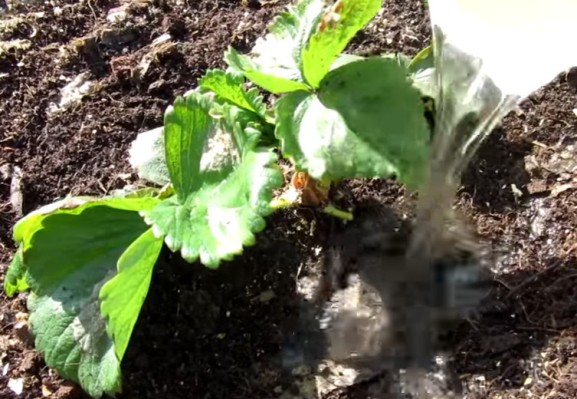
Root dressing
Root dressing involves the application of fertilizer directly under the strawberry bushes or at some distance from them. Sometimes dry fertilizers are scattered right next to the bushes.
For root dressing, as a rule, mineral fertilizers with macronutrients, as well as organics.

Foliar dressing
You can fertilize strawberries in spring for a good harvest not only under the root, but also on the leaves.
Note! It is believed that foliar dressing is most effective when the plant especially needs certain trace elements (which is manifested in its appearance). For example, in the case of chlorosis. In other words, they are carried out out of necessity.
Thus, foliar dressing, as a rule, is carried out with the help of fertilizers, which include trace elements.
Obviously! Foliar dressing cannot completely replace root dressing. Therefore, the root is the main dressing, and the foliar is additional (if necessary).
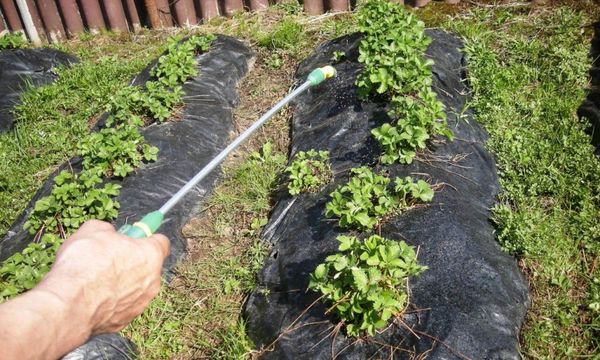
How to feed strawberries in spring for a good harvest: options for effective spring fertilizers
Naturally, before getting down to business, you need to figure out how you can and better feed strawberries in spring.
As with many other crops, mineral and organic fertilizers are used to feed strawberries.
Next, let's figure out what fertilizers can be used, how to combine them.
Nitrogen feeding
Remember! It is applied only once in early spring.
Mineral nitrogen fertilizers:
- Urea (carbamide) - 46% nitrogen (10-15 grams per 10 liters of water or per 1 square meter);
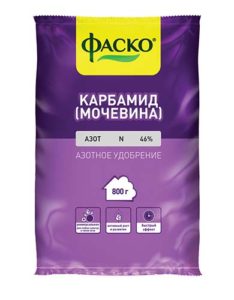
- Ammonium nitrate - 33% nitrogen (15-20 grams per 10 liters of water or per 1 square meter);
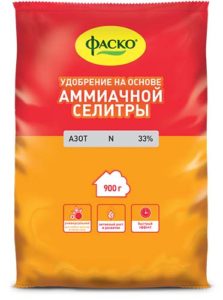
Organic fertilizers:
- infusion chicken droppings (usually 1 in 20);

- infusion cow dung or Mullein (1 in 40);
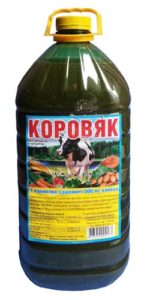
- green manure (nettle infusion).
Early spring feeding of strawberries is especially popular. chicken manure solution.
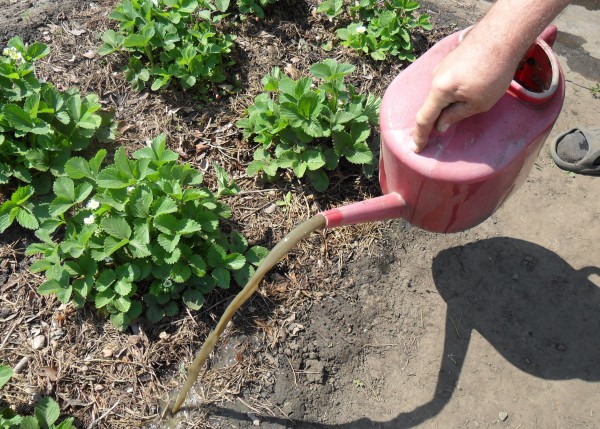
However! Due to the impressive content of macro- and microelements, such feeding is carried out 1 time.
To prepare a solution, organic matter is poured into a bucket and poured with water in a ratio of 1:20. The product is thoroughly stirred to a homogeneous consistency, poured into a watering can and water the bushes.
Video: feeding strawberries in spring with chicken droppings
Complex nitrogen-potassium-phosphorus feeding
Suitable for feeding before and after flowering.
- Nitroammofosk (nitrogen, phosphorus, potassium - all 16% each) - 2 tbsp. spoons (20-30 grams).
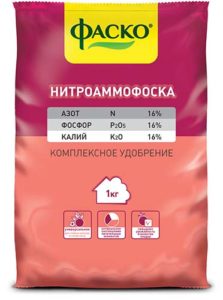
Better yet, take superphosphate - nitrogen 6-9%, phosphorus - 26-30% (20-30 grams).
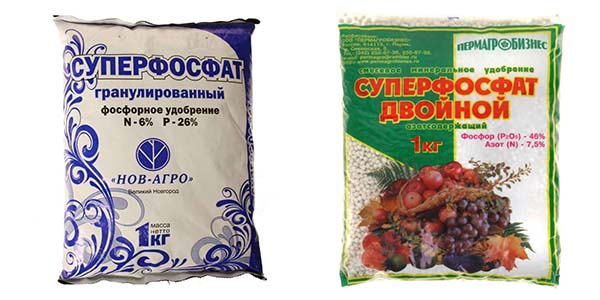
If you are using double superphosphate, and not simple (nitrogen 7.5-10%, phosphorus 46%), then the dose should be reduced by 1.5-2 times.
- Potassium sulfate (potassium sulfate) - 46-52% potassium (1 tablespoon - 10-15 grams).
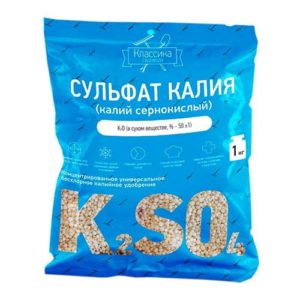
Dissolve and mix everything in 10 liters of water, and then pour 0.5 liters of solution under each bush.
By the way! Instead of potassium sulfate (potassium sulfate), you can use potassium salt.
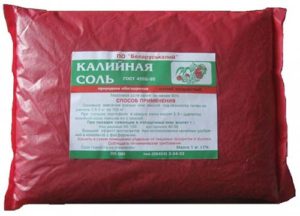
And it is also very convenient to use kalimagnesia, which, in addition to potassium, contains such an important trace element as magnesium.
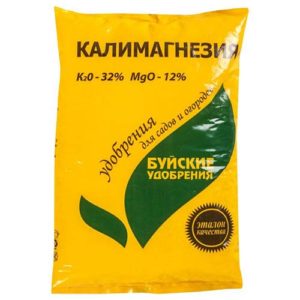
And if you proponent of organic farming, then you can as potash feeding use wood ash, having prepared the following solution (or even better infusion-extract): 100-200 grams of ash per 10 liters of water, and then pour 1 liter under each bush.
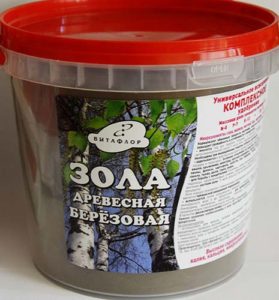
Concerning phosphorus, it is available in the same bone or fish meal.
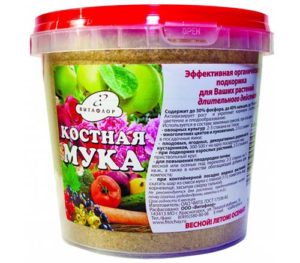
Rapidly assimilated phosphorus supplement
Suitable for feeding before and after flowering (during fruiting).
To make an easily digestible phosphorus fertilizer for spring feeding strawberries you need:
Take potassium monophosphate, dissolve in water and fertilize.
Or:
- 1 kg double superphosphate pour 5 liters of boiling water;
- After the water has cooled, add 0.5 liters of 9% vinegar;
Acidifying the water will help convert calcium phosphate to a more soluble form.
- Let it brew for 12-24 hours, shaking and stirring occasionally.
- Add another 5 liters of water, bringing the total volume to 10 liters.
- Then dilute 1 liter of the superphosphate infusion with 10 liters of water (1 to 10).
- Carry out top dressing.
Advice! The remaining phosphorus sediment can be dug under fruit trees.
Video: how to properly feed strawberries in spring with superphosphate
Autumn potassium-phosphorus feeding (after picking berries)
An excellent option for feeding strawberries after harvesting can be the following combination of mineral and organic fertilizers.
First option:
- Superphosphate - nitrogen 6-9%, phosphorus - 26-30% (10-20 grams per 10 liters of water).
Advice! The site has a separate article about how to apply superphosphate.

- Potassium sulfate (potassium sulfate) - 46-52% potassium (10-20 grams per 10 liters.

Second option:
- Nitroammofoska - 2 tbsp. spoons (20-30 grams).
- Wood ash - 1 glass (100 grams).
Third option:
- Diammofoska - 10% nitrogen, 26% each phosphorus and potassium (20-30 grams).
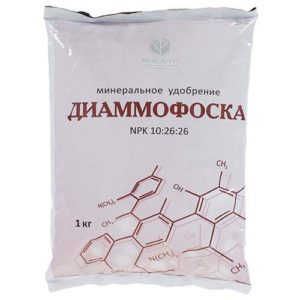
Fourth option:
- Potassium monophosphate (Phosphorus - 50%, potassium - 33%) - 10-15 grams;
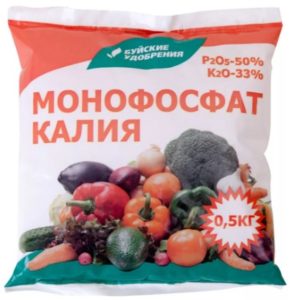
Dissolve everything, mix in 10 liters of water and pour 0.5-1 liter of solution under each bush.
Fertilizers for strawberries
If you do not want to bother (you are a "lazy" summer resident), then you can buy one of the special complex fertilizers for strawberries (garden strawberries), which already contains all the macro- and microelements, for example (apply everything according to the instructions on the packages):
- Fertika "Kristalon" for strawberries and strawberries (liquid complex fertilizer);
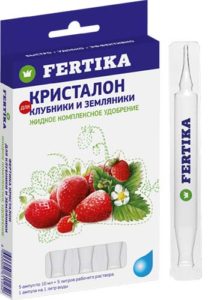
- Fertika "Garden and Vegetable Garden" for strawberries and strawberries (organic-mineral dry mix, with humates);
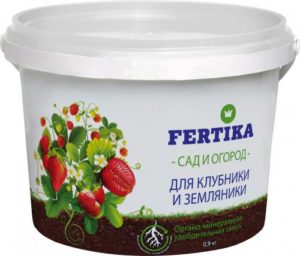
- Gumi-Omi "Berry" for raspberries, strawberries and other berry bushes (based on chicken manure).
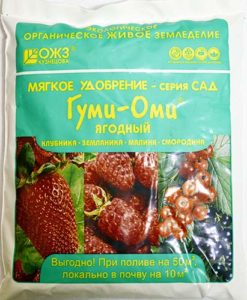
- Specialized long-acting fertilizers are especially popular (granular, it is advisable to apply them dry into holes along the diameter of the bushes, and then water). For example, "Strawberry»From Fusco.
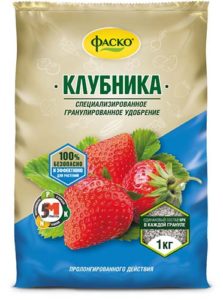
Fertilizers with humates and microelements
Very good to use humateswhich contribute to better absorption of mineral fertilizers. Therefore, you can first prepare a humate solution (for example, Potassium humate), and then add a complex mineral fertilizer to it, for example, the same Nitroammofosk.
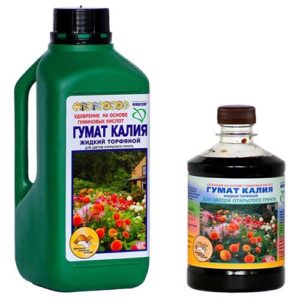
By the way! Now humates are initially added to some complex mineral fertilizers. For example, "Strong " from Fasco with potassium humate and trace elements.
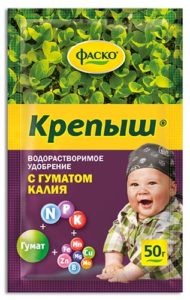
In general, it is very convenient to use for feeding strawberries ready-made cocktails with essential microelementstype Humate +7 Iodine.
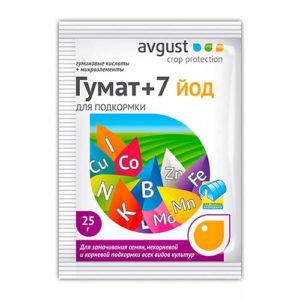
Folk remedies
Among folk remedies, feeding strawberries with yeast is very popular.
This is best done before flowering.
- 100 g of fresh yeast (or 30-35 grams of dry yeast, i.e. the ratio is 1 to 3) and 100 grams of sugar are dissolved in 5 liters of warm water and insisted for 1-3 days (to start the fermentation process), while not forgetting stir periodically. Then the resulting mother liquor is diluted 1 to 10 with water, poured into a watering can, and each plant is watered abundantly (about 0.5-1 liters).
Important! Adding yeast to the soil negates the presence of potassium in the soil (dissolves it), so immediately after a week add potassium supplement, for example, wood ash or potassium sulfate (potassium sulfate).
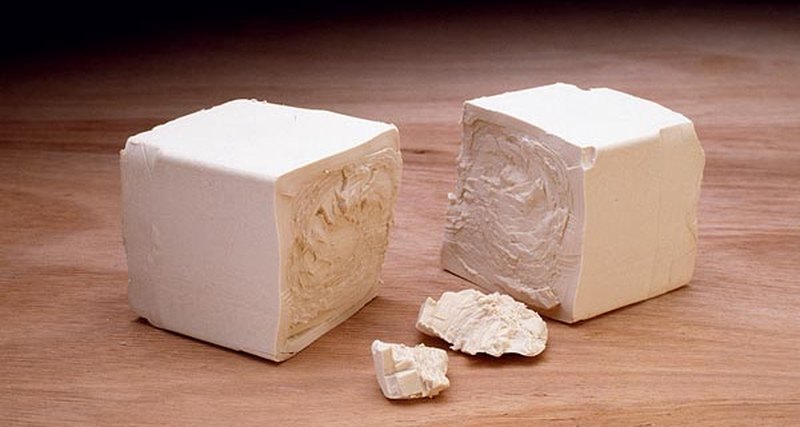
Video: how to feed strawberries in spring with yeast for growth and productivity
By the way! The composition of the top dressing (+ means of protection against diseases and pests) for strawberries based on boric acid, iodine, potassium permanganate and ammonia (ammonia).
Actually, for example, this video.
Video: feeding strawberries in spring with a solution of boric acid, iodine, potassium permanganate and ammonia
However! There is no point in feeding garden strawberries with this tank mixture. Better to just use a solution boric acid (without iodine, potassium permanganate, unless you can leave ammonia).
So to cook boric acid solution for foliar feeding according to leaves and flowers (i.e. during the flowering period), you need to dissolve 2-5 grams in 10 liters of water, and first it is better to dissolve it in 1 liter of warm water.
What else needs to be done in the spring to get a good strawberry harvest
The composition of measures for caring for strawberries in spring includes the following:
- opening after winter (removal of the winter shelter);
- spring pruning;
- loosening and weeding;
- directly feeding;
- watering;
- mulching;
- processing strawberries from diseases and pests.
By the way! The site also hasgeneral detailed article on spring strawberry care.
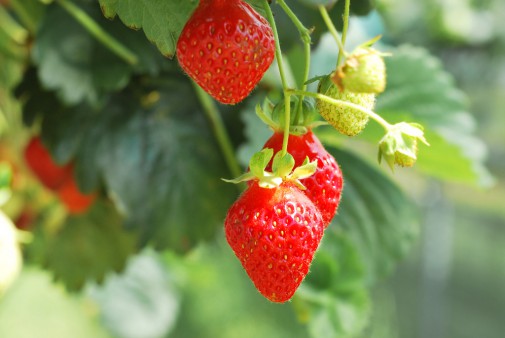
Thus, in order to get a rich strawberry harvest, you definitely need to feed the strawberry bushes in the spring. It is not difficult to do this, you just need to know exactly when, how and with what, in other words, to act according to the above instructions. And then the result will meet even the most daring expectations.
Video: the first spring feeding and the second for strengthening the berries


Hope! You are just a genius !!! Thank you very much for your work! Everything is so clear and accessible! For each question, everything is collected in one place - I have never met anything better than your articles. May God grant health and prosperity to you and your garden. Best regards Galina